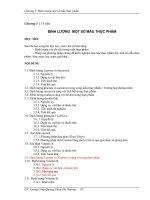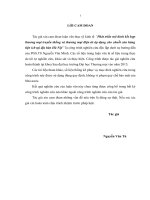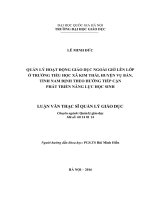CHẤT BÁN DẪN DỊCH TỪ TÀI LIỆU NƯỚC NGOÀI
Bạn đang xem bản rút gọn của tài liệu. Xem và tải ngay bản đầy đủ của tài liệu tại đây (232.37 KB, 4 trang )
1
Exercise 8: Semiconductor
Bài 8: Chất bán dẫn
A semiconductor is a material which has electrical
conductivity between that of a conductor such as
copper and that of an insulatorsuch as glass.
Semiconductors are the foundation of modern
electronics, including transistors, solar cells, lightemitting diodes (LEDs),quantum dots and digital
and analog integrated circuits. The modern
understanding of the properties of a
semiconductor relies onquantum physics to
explain the movement of electrons and holes
inside a lattice. An increased knowledge of
semiconductor materials and fabrication processes
has made possible continuing increases in the
complexity and speed of integrated semiconductor
devices.
Chất bán dẫn là một loại vật liệu có tính dẫn điện
nằm giữa một chất dẫn điện như đồng và một chất
cách điện như thủy tinh.
Chất bán dẫn là nền móng của điện tử học hiện
đại, bao gồm có điện trở, Pin năng lượng mặt trời,
đi ốt phát quang, chấm lượng tử, các thiết bị số,
mạch tích hợp kỹ thuật số và tương tự. Những
hiểu biết mới đây về tính chất của chất bán dẫn
đều dựa trên vật lý lượng tử để giải thích cho sự
chuyển động của các electron và các lỗ trống bên
trong mộng mạng tinh thể. Sự gia tăng hiểu biết
về vật liệu bán dẫn và phương pháp chế tạo làm
tăng thêm độ phức tạp và tốc độ của các thiết bị
bán dẫn tích hợp.
The electrical conductivity of a semiconductor
material increases with increasing temperature,
which is behaviour opposite to that of a metal.
Semiconductor devices can display a range of
useful properties such as passing current more
easily in one direction than the other, showing
variable resistance, and sensitivity to light or heat.
Because the electrical properties of a
semiconductor material can be modified by
controlled addition of impurities, or by the
application of electrical fields or light, devices
made from semiconductors can be used for
amplification, switching, and energy conversion.
Độ dẫn điện của vật liệu bán dẫn tăng cùng với sự
tăng của nhiệt độ, nó trái ngược với thuộc tính của
kim loại.
Các linh kiện bán dẫn có thể thể hển thị một loạt
các tích chất có ích như dễ dàng dịch chuyển dòng
điện theo một hướng khác, cho thấy khả năng biến
đổi trở kháng, và độ nhạy với ánh sáng và nhiệt
độ. Bởi vì tính chất điện của vật liệu bán dẫn có
thể điều chỉnh bởi cách thêm tạp chất hoặc bằng
ứng dụng của điện trường hoặc ánh sáng, thiết bị
làm từ chất bán dẫn có thể sử dụng trong máy
khuếch đại, chuyển mạch, và biến đổi năng lượng.
Current conduction in a semiconductor occurs
through the movement of free electrons and
"holes", collectively known as charge carriers.
Adding impurity atoms to a semiconducting
material, known as "doping", greatly increases the
number of charge carriers within it. When a doped
semiconductor contains mostly free holes it is
Dòng điện dẫn trong chất bán dẫn xảy ra nhờ sự
dịch chuyển của các điện tích tự do và các “lỗ
trống”, được gọi chung là hạt mạng điện. Việc
thêm các nguyên tử tạp chất vào một vật liệu bán
dẫn, được gọi là “ kích thích”, có thể làm tăng
đáng kể số lượng các hạt mang điện bên trong nó.
Khi chất bán dẫn pha tạp chứa phần lớn các lỗ
Nhóm 8
Nguyễn Hồng Thiết – Hoàng Thanh Phương
2
called "p-type", and when it contains mostly free
electrons it is known as "n-type". The
semiconductor materials used in electronic
devices are doped under precise conditions to
control the location and concentration of p- and n
type dopants. A single semiconductor crystal can
have many p- and n-type regions; the p–n
junctionsbetween these regions are responsible for
the useful electronic behaviour.
trống thì được gọi là “ loại p”, và khi chất bán dẫn
pha tạp chưa phần lớn các electron tự do thì được
gọi là “ loại n”. Các chất bán dẫn được dùng trong
các thiết bị điện tử được kích thích dưới điều kiện
chính xác để kiểm soát vị trí và nồng độ tạp chất
loại p và loại n. Một tinh thể bán dẫn đơn có thể
có nhiều vùng p và n, tiếp giáp giữa p-n chịu
trách nhiệm về sự có ích tính năng điện tử.
Some of the properties of semiconductor materials
were observed throughout the mid 19th and first
decades of the 20th century. Development of
quantum physics in turn allowed the development
of the transistor in 1948. Although some pure
elements and many compounds display
semiconductor properties, silicon, germanium, and
compounds of gallium are the most widely used in
electronic devices.
Một số tính chất của vật liệu bán dẫn được chú ý
đến trong suốt giữa thế kỷ 19 đến những thập niên
đầu thế kỷ 20. Sự phát triển của vật lý lượng tử
lần lượt cho phép sự phát triển của công nghệ bán
dẫn trong năm 1948. Mặc dù một số nguyên tố
tinh khiết và nhiều hợp chất biểu thị các tính chất
bán dẫn, silicon, germanium, và các hợp chất của
gallium là sử dụng rộng rãi nhất trong các thiết bị
điện tử.
The history of the understanding of
semiconductors begins with experiments on the
electrical properties of materials. The properties of
negative temperature coefficient of resistance,
rectification, and light-sensitivity were observed
starting in the early 19th century.
Lịch sử của sự hiểu biết về
chất bán dẫn được bắt đầu với thí nghiệm
tính chất điện của vật liệu.
Các tính chất của nhiệt độ âm, hệ số điện trở,sự
chỉnh lưu, độ nhảy với ánh sáng
được bắt đầu quan sát từ đầu thế kỷ thứ 19.
In 1833, Michael Faraday reported that the
resistance of specimens of silver sulfide decreases
when they are heated. This is contrary to the
behavior of metallic substances such as copper. In
1839, A. E. Becquerel reported observation of a
voltage between a solid and a liquid electrolyte
when struck by light, the photovoltaic effect. In
1873 Willoughby Smith observed that selenium
resistors exhibit decreasing resistance when light
falls on them. In 1874 Karl Ferdinand Braun
observed conduction and rectification in metallic
sulphides, and Arthur Schuster found that a
Vào năm 1833, Michael Faraday báo cáo rằng
điện trở của những mẫu sunfua bạc giảm đi khi
chúng được đun nóng. Điều này trái ngược với
đặc tính của kim loại như đồng. Năm 1830, A. E.
Becquerel báo cáo quá trình quan sát hiệu điện thế
giữa một vật rắn và dung điện điện phân khi có
ánh sáng chiếu vào, đã suất hiện hiệu ứng quang
điện. Năm 1873, Willoughby Smith đã quan sát
được điện trở của chất Selen giảm khi được ánh
sáng chiều vào. Năm 1874, Karl Ferdnand Braun
quan sát được sự truyền dẫn và tính chỉnh lưu của
miếng kim loại sunfua, và Arthur Schuster phát
Nhóm 8
Nguyễn Hồng Thiết – Hoàng Thanh Phương
3
copper oxide layer on wires has rectification
properties that ceases when the wires are cleaned.
Adams and Day observed the photovoltaic effect
in selenium in 1876.
hiện ra rằng lớp oxit đồng bám trên sợi dây có tính
dẫn lưu bị ngưng khi sợi dây được làm sạch.
Adams và Day quan sát được hiệu ứng quang điện
trên Selen vào năm 1876.
A unified explanation of these phenomena
required a theory of solid-state physics which
developed greatly in the first half of the 20th
Century. In 1878 Edwin Herbert Hall
demonstrated the deflection of flowing charge
carriers by an applied magnetic field, the Hall
effect. The discovery of the electron by J.J.
Thomson in 1897 prompted theories of electronbased conduction in solids. Karl Baedeker, by
observing a Hall effect with the reverse sign to
that in metals, theorized that copper iodide had
positive charge carriers.Johan Koenigsberger
classified solid materials as metals, insulators and
"variable conductors" in 1914. Felix Bloch
published a theory of the movement of electrons
through atomic lattices in 1928. In 1930, B.
Gudden stated that conductivity in semiconductors
was due to minor concentrations of impurities. By
1931, the band theory of conduction had been
established by Alan Herries Wilson and the
concept of band gaps had been developed. Walter
H. Schottky and Nevill Francis Mott developed
models of the potential barrier and of the
characteristics of a metal-semiconductor junction.
By 1938, Boris Davydov had developed a theory
of the copper-oxide rectifer, identifying the effect
of the p–n junction and the importance of minority
carriers and surface states.
Một sự giải thích thống nhất về những hiện tượng
đòi hỏi một học thuyết về vật lý bán dẫn, nó rất
phát triển vào nữa đầu thế kỷ 20. Năm 1878,
Edwin Herbert Hall đã chứng minh được sự lệch
hướng của các phần tử mang điện khi đặc trong
từ trường, đó là hiệu ứng Hall. Việc phát hiện ra
các electron bởi J.J. Thomson vào năm 1897 thúc
đẩy các thuyết về cở sở điện tử truyền dẫn trong
chất rắn. Karl Baedeker, bằng cách quan sát hiệu
ứng Hall với các dấu hiệu trái ngược với kim loại,
đã đưa ra thuyết về đồng Ioddua có hạt mang điện
tích cực. Johan Koenigsbergr đã phân loại vật chất
rắn thành kim loại, vật cách điện, và “ vật dẫn
biến” vào năm 1914. Felix Bloch đã công bố học
huyết về sự dịch chuyển của các Electron xuyên
qua dàn nguyên tử vào năm 1928. Vào năm 1930,
B. Gudden phát biểu rằng tính dẫn điện trong chất
bán dẫn là do có hàm lượng nhỏ tạp chất. Vào
năm 1931, học huyết giải băng dẫn đã được chứng
minh bởi Alan Herries Wilson và khái niệm về dải
khoảng cách đã được phát triển. Walter H.
Shottky và Nevill Francis Mott đã trình bày mô
hình của hàng rào thế năng và đặc điểm của lớp
tiếp giáp kim loại - chất bán dẫn. Vào năm 1938,
Boris Davydov đã phát triển học thuyết về chỉnh
lưu đồng- oxit, sự thông nhất hiệu ứng của lớp
tiếp giáp p-n và tầm quan trọng của vật mang điện
thiểu số và trạng thái bề mặt.
Agreement between theoretical predictions (based
on developing quantum mechanics) and
experimental results was sometimes poor. This
was later explained by John Bardeen as due to the
extreme "structure sensitive" behavior of
Sự phù hợp giữa dự đoán lý thuyết ( dựa trên sự
phát triển của cơ học lượng tử) và kết quả thực
nghiệm đôi khi kém. Điều này sau đó đã được giải
thích bởi John Bardeen là do một trường hợp đặc
biệt trạng thái “ cấu trúc nhạy cảm” của chất bán
Nhóm 8
Nguyễn Hồng Thiết – Hoàng Thanh Phương
4
semiconductors, whose properties change dẫn, mà tích chất thay đổi đáng kể dựa trên một
dramatically based on tiny amounts of impurities. lượng nhỏ tạp chất.
Commercially pure materials
of the 1920s containing varying proportions of
trace
contaminants
produced
differing
experimental
results.
This
spurred
the
development of improved material refining
techniques, culminating in modern semiconductor
refineries producing materials with parts-pertrillion purity.
Theo quan điểm thương mai, vật liệu liệu nguyên
chất nhưng năm 1920 chứa đựng tỷ lệ khác nhau
của một ít chất làm ô nhiểm được sản xuất khác
nhau dứa trên kết quả thí nghiệm. Điều này đã
thúc đẩy sự phát triển việc cải tiến trong kỹ thuật
tinh chế vật liệu, mà đỉnh cao trong các các nhà
máy tinh chế chất bán dẫn là những sản phẩm với
một phần nghìn tỉ độ tinh khiết.
Devices using semiconductors were at first
constructed based on empirical knowledge, before
semiconductor theory provided a guide to
construction of more capable and reliable devices.
Các thiết bị sử dụng chất bán dẫn đầu tiên được
sản xuất dựa trên kiến thức thực nghiệm, trước khi
thuyết bán dẫn cung cấp hướng dẫn để sản xuất
các thiết bị hiệu quả và đáng tin cậy hơn
Nhóm 8
Nguyễn Hồng Thiết – Hoàng Thanh Phương









